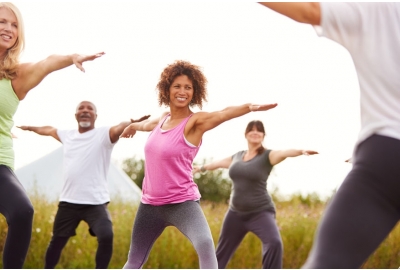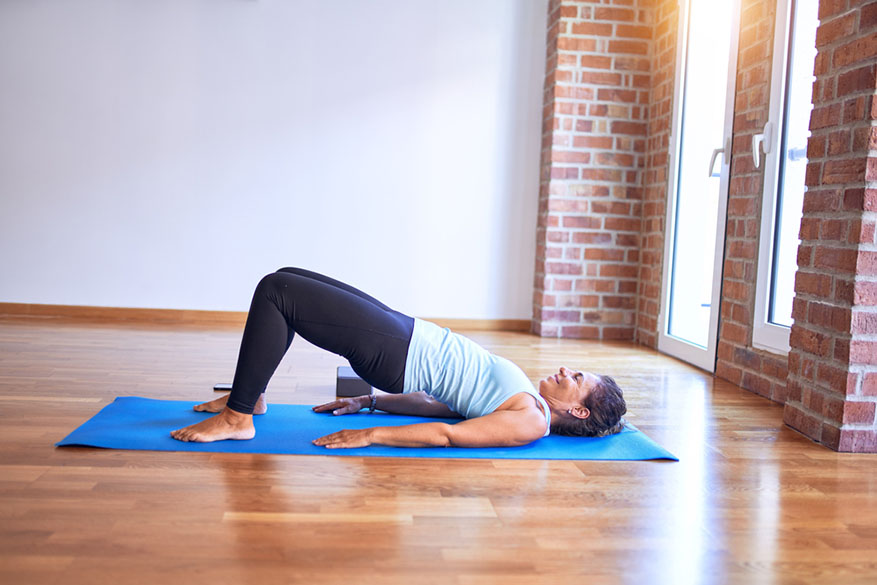
Yoga for Menopause: Benefits, Poses, and More

Source: Monkey Business Images/Shutterstock.com
Managing hot flashes, anxiety, mood swings, and other side effects of menopause? Then roll out the mat, dim the lights, and get your yoga on! Yoga for menopause offers many benefits and has been found to lighten and minimize all the bodily changes you might be feeling.
Let’s dive into some of the benefits and relief yoga offers menopausal women. Then, explore the four yoga poses we have listed below to target the menopausal symptoms you’re personally experiencing. Try several and find the right yoga flow for you!
The Benefits of Yoga for Menopause
Yoga offers lots of benefits for menopause. Just like yoga for the pelvic floor offers many benefits like improved flexibility and pain management, specific yoga poses provide menopause relief.
Take, for example, hot flashes, which 80 percent of menopausal women experience. Often brought on by stress and intense activities, a hot flash can leave women with a surge of heat followed by chills and a clammy feeling. However, cooling and restorative yoga poses are wonderful for combating hot flashes, bringing the body’s temperature back to normal.
Another example is pelvic floor exercises, like the Mula bandha, that offer relief for incontinence, which also helps menopausal symptoms. When it comes to menopause and bloating, specific stretches and poses can help in hormonal imbalances and the digestive-related side effects that come with it.
Furthermore, for some women, yoga has been found as a more natural alternative to Hormone Replacement Therapy (HRT), which some studies have linked to an increased risk of breast cancer, heart disease, and other conditions.
Discover Top Products for Menopause Relief
4 Yoga Poses for Menopausal Symptoms

Source: Krakenimages.com/Shuttertsock.com
Are you looking to start yoga for menopause? Here is a list of four yoga poses that can help reduce symptoms and get you back to feeling like yourself.
Considered restorative poses, many poses listed below are not intended to get the heart rate up or deepen a stretch but to alleviate pain points and improve energy and brain function. So, if you are accustomed to more strenuous yoga poses, you may find it helps to perform lighter variations and make modifications. For instance, you can use the help of bolsters or a chair, blankets, and blocks.
#1 Supta Baddha Konasana (Reclining Bound Angle Pose)
The reclining bound angle pose is an excellent yoga pose for hot flashes. It also acts as a stress and tension reliever and offers a boost of energy when experiencing mild depression. However, if you have a groin or knee injury, use a blanket or block under your outer thighs for additional support.
- Sitting on the mat, stretch your legs out in front and bend the knees up, bringing together the soles of your feet.
- Slowly drop your knees to each side and lean backward, bringing the elbows into the mat for abdominal support, if needed. If you can’t lean all the way onto the mat, use a blanket or rest each knee on a block.
- At this point, shift your bum and lower weight to curve the lower back.
- Once in position, close your eyes and release all the tension in the body, from the toes to the head and spine. Stay for 10 minutes, breathing deeply, and then bring the knees together and roll back into a seated position.
#2 Adho Mukha Svanasana (Downward-Facing Dog)
Downward-facing dog offers all kinds of relief for menopause symptoms — and beyond! For starters, it calms the brain, energizes the body, improves digestion, and offers strength-building for preventing osteoporosis and back pain like sciatica.
- With hands and knees on the mat, align your hips to your knees and hands beneath the shoulders. Curl your toes and straighten each leg while pushing up with your hands.
- Position your heels as close to the floor as possible. If you can’t, that’s okay! But push the flexibility a little farther each time until your heels rest flat.
- Drop your head so that your ears align with the shoulders and then stretch. As your back muscles relax, you should feel your legs getting tight.
- Hold the pose for 20 seconds, if possible, inhaling and exhaling slowly.
- Slowly roll out of position by pushing your body forward and lowering the knees, arms, and entire body while bending at the elbows.
Practice More Poses for the Pelvic Floor
#3 Setu Bandha Sarvangasana (Bridge Pose)

Source: Krakenimages.com/Shuttertsock.com
The bridge pose stretches the back, neck, and spine, which helps to reduce anxiety, fatigue, headaches, insomnia, and anything else associated with that region. It’s also great for osteoporosis and sinuses. However, take caution if you have a neck injury.
- Begin on your mat by lying flat on your back. If needed, place a supportive blanket under your neck and shoulders.
- With your hands lying flat on the mat, palms facing down, bend your knees so that your feet are also flat on the mat as well and your heels are snug against the bum.
- In this position, lift the pelvic area off the mat and, using the support of your arms to press into the mat, bring your hands together beneath your arched back, clasping them together if you can.
- Breathing along, hold the bridge pose for up to one minute while keeping your chin to the sky.
- When complete, release the spine, bringing it slowly toward the mat with a final exhale.
#4 Prasarita Padottanasana (Wide-Legged Forward Bend)
The wide-legged forward bend yoga poses for menopause help to calm the brain, fight fatigue, headaches, and mild depression.
- Stand on the mat sideways, spreading your legs three feet apart while keeping your feet parallel and straight.
- With your hands on your hips, hinge forward slowly until you form a 90-degree angle to the upper body and hips, releasing your arms if possible.
- Connect your arms behind your back. If you can’t reach, use a yoga strap and bring your hands close together.
- Now, slowly move your upper body toward the mat and allow your head to rest between your feet, remembering to create distance between the shoulders and ears while stretching your arms, neck, and legs.
- Breathing deeply, hold the pose for 30 seconds to one minute. Then, release your arms and let them fall towards the mat.
- Come back into a standing position, walking your legs together.